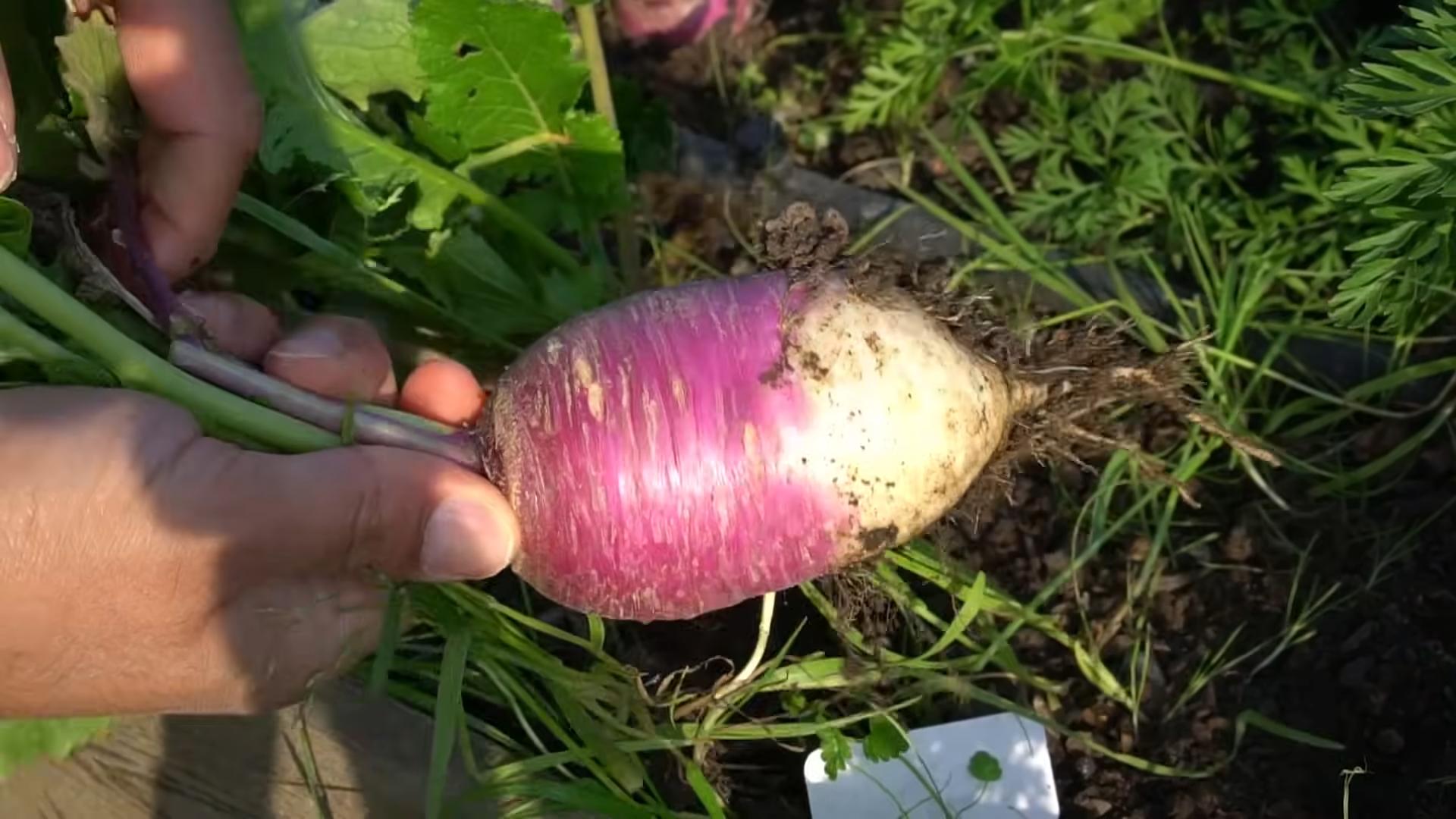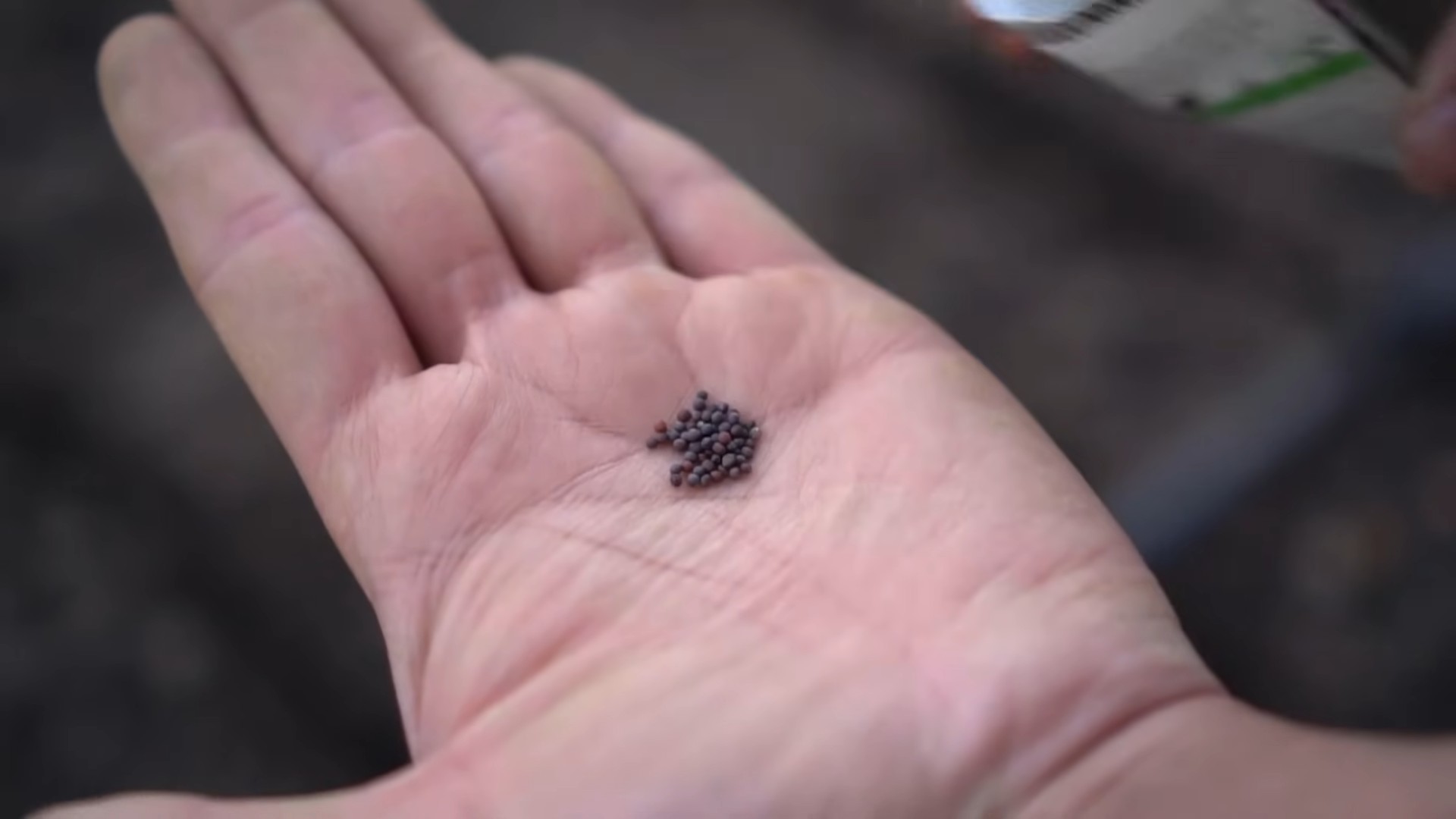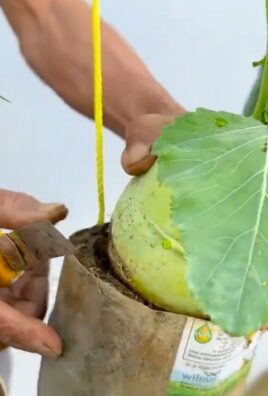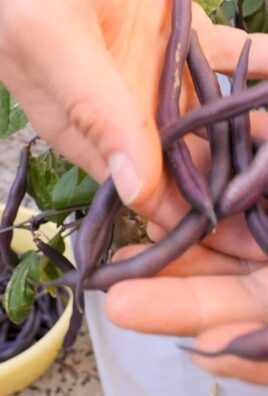Growing Turnips at Home might sound like something your grandparents did, but trust me, this root vegetable is making a serious comeback! Forget those bland, store-bought turnips – imagine pulling fresh, crisp, slightly sweet turnips straight from your own backyard. Sounds delicious, right?
For centuries, turnips have been a staple in diets across the globe, from ancient Rome to medieval Europe. They were a lifesaver during lean winter months, providing essential nutrients when other crops were scarce. While they might not be as glamorous as tomatoes or peppers, turnips are incredibly versatile and easy to grow, even for beginner gardeners like myself. I remember my first attempt – a few bumpy, but delicious turnips that made the best mashed side dish!
But why should you bother growing turnips at home in today’s world of readily available produce? Well, for starters, homegrown turnips taste infinitely better. Plus, you control exactly what goes into them – no pesticides or questionable fertilizers. More importantly, it’s incredibly rewarding to nurture something from seed to table. In this article, I’m going to share my favorite DIY tricks and hacks to help you cultivate a thriving turnip patch, no matter how small your space. Get ready to discover the joy of fresh, homegrown turnips!

Growing Turnips: A Beginner’s Guide to a Bountiful Harvest
Okay, so you want to grow turnips? Awesome! They’re surprisingly easy to cultivate, and nothing beats the taste of fresh, homegrown veggies. I’m going to walk you through everything you need to know, from prepping the soil to harvesting your delicious turnips. Let’s get started!
Choosing Your Turnip Variety
First things first, let’s talk about turnip varieties. There are tons to choose from, each with its own unique characteristics. Here are a few popular options:
* Purple Top White Globe: This is a classic, reliable variety known for its mild flavor and smooth, white flesh with a purple top. It’s a great all-around choice.
* Tokyo Cross: If you’re looking for something quick-growing, Tokyo Cross is your best bet. They mature super fast and have a sweet, delicate flavor.
* Golden Ball: As the name suggests, this variety produces round, golden-yellow turnips. They’re known for their sweet and nutty flavor.
* Hakurei: This Japanese turnip is incredibly tender and mild, perfect for eating raw in salads.
Consider your taste preferences and growing conditions when making your selection. I personally love Purple Top White Globe because they’re so versatile.
Preparing Your Garden Bed
Turnips thrive in well-drained, fertile soil. Here’s how to get your garden bed ready:
1. Choose a Sunny Spot: Turnips need at least 6 hours of sunlight per day. Pick a location in your garden that gets plenty of sunshine.
2. Clear the Area: Remove any weeds, rocks, or debris from the planting area.
3. Loosen the Soil: Use a garden fork or tiller to loosen the soil to a depth of at least 12 inches. This will allow the turnip roots to grow easily.
4. Amend the Soil: Turnips prefer a slightly acidic soil with a pH between 6.0 and 6.8. You can test your soil pH with a soil testing kit. If your soil is too alkaline, you can amend it with sulfur or peat moss.
5. Add Compost or Manure: Incorporate plenty of compost or well-rotted manure into the soil. This will provide essential nutrients and improve drainage. I usually add a few inches of compost and mix it in thoroughly.
6. Rake the Soil Smooth: Once you’ve amended the soil, rake it smooth to create a level planting surface.
Planting Turnip Seeds
Now for the fun part – planting! Turnips are typically planted in early spring or late summer for a fall harvest.
1. Check the Planting Dates: Consult your local planting calendar to determine the best time to plant turnips in your area. Generally, you can plant them 4-6 weeks before the last expected frost in spring or 6-8 weeks before the first expected frost in fall.
2. Create Rows: Use a garden rake or hoe to create shallow rows in the soil, about 12-18 inches apart.
3. Sow the Seeds: Sprinkle the turnip seeds evenly along the rows, spacing them about 1 inch apart. Turnip seeds are tiny, so don’t worry about being too precise.
4. Cover the Seeds: Gently cover the seeds with about 1/2 inch of soil.
5. Water Thoroughly: Water the planting area thoroughly with a gentle spray. Keep the soil consistently moist until the seeds germinate.
Caring for Your Turnip Plants
Once your turnip seeds have sprouted, it’s important to provide them with proper care to ensure a healthy harvest.
1. Thin the Seedlings: When the seedlings are about 2-3 inches tall, thin them to about 3-4 inches apart. This will give the turnips enough room to grow. Don’t just toss the thinnings! You can eat the young turnip greens in salads or stir-fries.
2. Water Regularly: Turnips need consistent moisture to thrive. Water them regularly, especially during dry spells. Aim for about 1 inch of water per week.
3. Weed Regularly: Keep the garden bed free of weeds, which can compete with the turnips for nutrients and water. Hand-pull weeds carefully to avoid disturbing the turnip roots.
4. Fertilize (Optional): If your soil is poor, you can fertilize your turnip plants with a balanced fertilizer. Follow the instructions on the fertilizer package. I usually don’t fertilize unless the plants look like they need a boost.
5. Monitor for Pests and Diseases: Keep an eye out for common turnip pests, such as aphids, flea beetles, and cabbage worms. You can control these pests with insecticidal soap or neem oil. Turnips are also susceptible to certain diseases, such as clubroot and powdery mildew. Practice good garden hygiene to prevent these diseases.
Harvesting Your Turnips
The moment you’ve been waiting for! Turnips are typically ready to harvest in 50-70 days, depending on the variety.
1. Check for Size: Harvest turnips when they reach the desired size. Most varieties are best harvested when they are about 2-3 inches in diameter.
2. Loosen the Soil: Use a garden fork to loosen the soil around the turnips.
3. Pull the Turnips: Gently pull the turnips from the ground, holding them by the base of the leaves.
4. Trim the Leaves: Cut off the turnip greens, leaving about 1 inch of stem attached to the turnip. Don’t throw away the greens! They’re delicious and nutritious.
5. Wash and Store: Wash the turnips thoroughly and store them in a cool, dry place. They can be stored in the refrigerator for several weeks.
Enjoying Your Turnip Harvest
Now that you’ve harvested your turnips, it’s time to enjoy them! Here are a few ideas:
* Roasted Turnips: Toss turnip cubes with olive oil, salt, and pepper, and roast them in the oven until tender and slightly caramelized.
* Mashed Turnips: Boil turnip cubes until tender, then mash them with butter, milk, and seasonings.
* Turnip Greens: Sauté turnip greens with garlic, olive oil, and a pinch of red pepper flakes.
* Turnip Soup: Add turnip cubes to your favorite vegetable soup recipe.
* Raw Turnips: Thinly slice raw turnips and add them to salads or slaws.
Troubleshooting Common Turnip Growing Problems
Even with the best care, you might encounter a few challenges when growing turnips. Here are some common problems and how to address them:
* Poor Germination: If your turnip seeds don’t germinate well, it could be due to several factors, such as poor soil, improper planting depth, or lack of moisture. Make sure to use fresh seeds, prepare the soil properly, and keep the soil consistently moist.
* Slow Growth: If your turnip plants are growing slowly, it could be due to lack of nutrients, insufficient sunlight, or competition from weeds. Fertilize the plants, ensure they get enough sunlight, and keep the garden bed free of weeds.
* Bolting: Bolting is when turnip plants prematurely flower and produce seeds. This can happen if the plants are stressed by heat, drought, or poor soil. Provide consistent moisture, protect the plants from extreme heat, and amend the soil with compost or manure.
* Pest Infestations: As mentioned earlier, turnips are susceptible to various pests. Monitor your plants regularly and take action promptly if you notice any signs of infestation.
* Diseases: Practice good garden hygiene to prevent turnip diseases. Avoid overcrowding the plants, water them at the base, and remove any infected leaves or plants.
Extending Your Turnip Growing Season
Want to enjoy fresh turnips for as long as possible? Here are a few tips for extending your growing season:
* Succession Planting: Plant a new batch of turnip seeds every 2-3 weeks to ensure a continuous harvest.
* Cold Frames or Row Covers: Use cold frames or row covers to protect your turnip plants from frost and extend the growing season into the fall and winter.
* Choose Cold-Hardy Varieties: Select turnip varieties that are known for their cold hardiness.
Turnip Greens: A Bonus Harvest!
Don’t forget about the turnip greens! They’re a delicious and nutritious bonus harvest. You can harvest turnip greens at any time during the growing season. Simply cut off the outer leaves, leaving the inner leaves to continue growing. Turnip greens are rich in vitamins, minerals, and antioxidants.
Final Thoughts
Growing turnips is a rewarding experience. With a little bit of planning and effort, you can enjoy a bountiful harvest of fresh, homegrown turnips. So, get out there and start planting! I promise, you won

Conclusion
So, there you have it! Growing turnips at home is not only achievable, but it’s a rewarding experience that puts fresh, flavorful produce right at your fingertips. We’ve walked you through the simple steps, from selecting the right variety to harvesting your bounty, and hopefully dispelled any myths about turnips being difficult to cultivate.
Why is this DIY gardening trick a must-try? Because it offers a level of control and freshness you simply can’t get from store-bought turnips. Imagine the satisfaction of pulling a crisp, sweet turnip from your own garden, knowing exactly where it came from and how it was grown. Plus, growing your own vegetables is a fantastic way to connect with nature, reduce your carbon footprint, and save money on your grocery bill.
But the fun doesn’t stop there! Feel free to experiment with different varieties of turnips. Try the classic ‘Purple Top White Globe’ for its mild flavor and versatility, or venture into more exotic options like ‘Golden Ball’ for a sweeter taste and vibrant color. You can also adjust your planting schedule to ensure a continuous harvest throughout the growing season. Consider succession planting, sowing new seeds every few weeks, to enjoy a steady supply of fresh turnips.
Furthermore, don’t limit yourself to just the roots! Turnip greens are incredibly nutritious and delicious. They can be steamed, sautéed, or added to soups and stews. Experiment with different cooking methods to find your favorite way to enjoy this often-overlooked part of the plant. You can even pickle the turnip roots for a tangy and flavorful condiment.
Growing turnips at home is more than just a gardening project; it’s an opportunity to embrace a healthier, more sustainable lifestyle. It’s a chance to connect with the earth, learn new skills, and enjoy the fruits (or rather, roots!) of your labor.
We wholeheartedly encourage you to give this DIY trick a try. Start small, perhaps with just a few plants, and see how it goes. Don’t be afraid to experiment and learn from your mistakes. Gardening is a journey, and every season brings new lessons and opportunities.
Most importantly, we want to hear about your experience! Share your successes, your challenges, and your favorite turnip recipes in the comments below. Let’s create a community of home gardeners who are passionate about growing their own food. Together, we can inspire others to embrace the joys of gardening and enjoy the delicious rewards of growing turnips at home. So, grab your seeds, get your hands dirty, and let the turnip-growing adventure begin!
Frequently Asked Questions (FAQ)
What is the best time of year to plant turnips?
Turnips are a cool-season crop, meaning they thrive in cooler temperatures. The best time to plant them depends on your climate. In general, you can plant turnips in early spring for a late spring/early summer harvest, or in late summer/early fall for a fall/winter harvest. For a spring crop, sow seeds 4-6 weeks before the last expected frost. For a fall crop, sow seeds 6-8 weeks before the first expected frost. Check your local weather forecast and planting guides for specific recommendations for your region.
How much sunlight do turnips need?
Turnips need at least 6 hours of direct sunlight per day to grow well. Choose a planting location that receives plenty of sunlight throughout the day. If you live in a particularly hot climate, some afternoon shade can be beneficial to prevent the plants from overheating.
What kind of soil is best for growing turnips?
Turnips prefer well-drained, fertile soil with a pH between 6.0 and 6.8. Amend your soil with compost or other organic matter to improve drainage and fertility. Avoid planting turnips in heavy clay soil, as this can lead to root rot. If you have clay soil, consider growing turnips in raised beds or containers.
How often should I water my turnips?
Turnips need consistent moisture to grow well. Water them regularly, especially during dry periods. Aim to keep the soil consistently moist but not waterlogged. A good rule of thumb is to water deeply once or twice a week, depending on the weather conditions. Use a soaker hose or drip irrigation to water the plants at the base, avoiding wetting the foliage, which can increase the risk of fungal diseases.
How far apart should I plant turnip seeds?
Sow turnip seeds about ½ inch deep and 1 inch apart in rows that are 12-18 inches apart. Once the seedlings emerge, thin them to 3-4 inches apart for smaller varieties and 4-6 inches apart for larger varieties. This will give the turnips enough space to develop properly.
When are turnips ready to harvest?
Turnips are typically ready to harvest 50-60 days after planting. The size of the turnip will depend on the variety, but generally, they are best harvested when they are 2-3 inches in diameter. You can harvest the greens at any time, but they are most tender when young. To harvest the roots, gently loosen the soil around the turnip and pull it out of the ground.
Are turnip greens edible?
Yes, turnip greens are edible and highly nutritious! They are a good source of vitamins A, C, and K, as well as calcium and fiber. You can harvest the greens at any time, but they are most tender when young. Wash the greens thoroughly before cooking. They can be steamed, sautéed, or added to soups and stews.
What are some common pests and diseases that affect turnips?
Some common pests that affect turnips include aphids, flea beetles, and root maggots. Common diseases include clubroot and powdery mildew. To prevent pest and disease problems, practice good garden hygiene, such as removing weeds and debris from the garden. You can also use organic pest control methods, such as insecticidal soap or neem oil. Choose disease-resistant varieties of turnips whenever possible.
Can I grow turnips in containers?
Yes, you can grow turnips in containers. Choose a container that is at least 12 inches deep and wide. Fill the container with well-draining potting mix. Sow the seeds as directed above and water regularly. Container-grown turnips may need to be watered more frequently than those grown in the ground.
How can I store turnips after harvesting?
To store turnips, remove the greens and wash the roots thoroughly. Store them in a cool, dark, and humid place, such as a root cellar or refrigerator. They can be stored for several months under the right conditions. You can also freeze turnips by blanching them for a few minutes and then placing them in freezer bags.





Leave a Comment